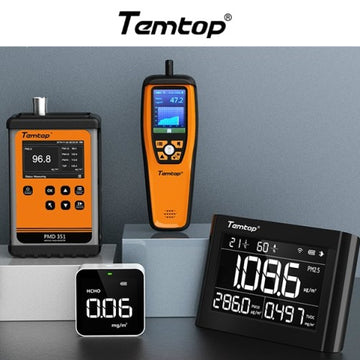Temtop M2000 2nd Generation Air Quality Monitor User Manual
Factors Affecting Air Quality
PM2.5 (Particulate Matter 2.5) refers to fine particles with diameter of 2.5 micrometers or less. Due to its tiny size, PM2.5 can be absorbed into bloodstream and the lungs, so that long-term exposure to high concentration of PM2.5 environment may cause eye and nose irritation, cough, asthma, emphysema, lung disease, heart attacks, cancer and etc.
PM10 (Particulate Matter 10) refers to particulates with a diameter of 10 micrometers or less. Due to the larger size, it's inhalable but penetrates no further than bronchi as larger particles can be filtered out by cilia and mucus of nose and throat. It normally considered as less harmful to health than PM2.5.
Formaldehyde (HCHO) is a colorless and strong-smelling gas with formula CH20, which has been classified by IARC as Group 1 carcinogen. Long-term exposure to just low doses could cause chronic respiratory diseases, nasopharyngeal carcinoma, colon cancer, brain tumors, nuclear gene mutation and etc.
TVOC (Total Volatile Organic Compounds) refers to various common VOCs including benzene, toluene, styrene, formaldehyde and etc. Due to their volatility as well as toxicity, irritability and carcinogenicity, long-term exposure to TVOCs can cause damage to the skin, liver, kidneys, central nervous system and etc.
CO2 (Carbon Dioxide) refers to a colorless and odorless gas that is usually derived from the breath of humans and animals. High CO2 concentration means that fresh air or ventilation is required, otherwise it may cause problems such as drowsiness, dizziness, loss of attention, and cognitive impairment.
Important!
Do not place detector in heavily polluted environments (concentration of HCHO >1.0mg/m3 or particle > 500 g/m) for a long time; or it may cause damages to the sensor.
Do not cover the air inlet/outlet during detection; or let fluff or hair enter the detector.
Do not make contact with organic solvents, such as glue/adhesives/paint/alcohol etc.
Do not use detector in humid places or environments with strong odor to maintain accuracy.
Do not use in environments contain gases listed in FAQ 6 to avoid influences on HCHO sensor.
If battery level shows 0, please charge the detector promptly to avoid effects during use (also chargeable when turned off).

Warning!
First use or unused for a long time: please put it outside over 6 hours for calibration.
Indoor use: keep the room/area airtight for 10 minutes to obtain more accurate results.
When calibrating the CO2 and formaldehyde sensors, please adjust the detector to the calibration interface and place it outdoors in a cool and ventilated environment for 5 minutes. Detection results will be much more accurate.
FAQ
Q: Why is the data reading very high/over-range after the detector is turned on?
A: As being packed in ink printed package box over time may interfere with the sensor due to the remaining organic volatile residue inside the package. Therefore, after unpacking, please put the detector in a ventilated place to help accelerate its data recovery.
Q: Why is data reading unstable?
A: As airflow in the environment is changing, the distribution of organic matter concentration may be uneven. Temtop recommends trying again in low airflow areas.
Q: Why is the test result abnormal or below normal?
A: Please check whether the air inlet or outlet has been covered or fluid is in. Gently shake the detector during detection to increase the interaction with surrounding air. The sensor may be not recovered. Please place the detector outdoors for ventilation.
Q: Can the calibration be accelerated if the detector is facing the outlet of air conditioner / fan?
A: No. The temperature difference or air flow speed at the air conditioner/fan outlet is relatively high, which may cause condensation or temperature changes on the sensor, affecting its detection performance. Please put the detector outdoors in a cool ventilated place.
Q: Why is the PM2.5 reading constantly changing?
A: As PM2.5 concentration in the environment is changing all the time not only due to environment factors like changes in airflow, humidity, wind direction and etc. but also due to common pollutant sources like smoking, cooking; exhaust emissions from vehicles, smoke from burning coal/chimneys/furnaces and etc. All these may influence the PM2.5 concentrations and give differences in the readings.
Product Link: https://www.temtop.co.uk/products/m2000-2nd?blog

























